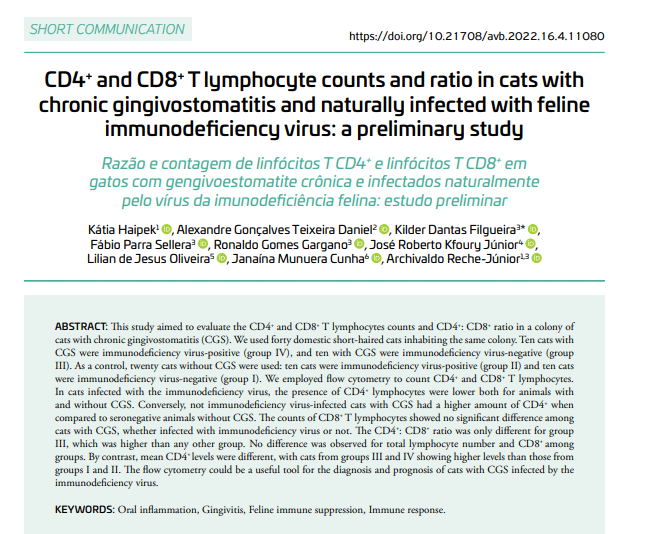CD4+ and CD8+ t lymphocyte counts and ratio in cats with chronic gingivostomatitis and naturally infected with feline immunodeficiency virus: a preliminary study
DOI:
https://doi.org/10.21708/avb.2022.16.4.11080Abstract
This study aimed to evaluate the CD4+ and CD8+ T lymphocytes counts and CD4+: CD8+ ratio in a colony of cats with chronic gingivostomatitis (CGS). We used forty domestic short-haired cats inhabiting the same colony. Ten cats with CGS were immunodeficiency virus-positive (group IV), and ten with CGS were immunodeficiency virus-negative (group III). As a control, twenty cats without CGS were used: ten cats were immunodeficiency virus-positive and (group II) and ten cats were immunodeficiency virus-negative (group I). We employed flow cytometry to count CD4+ and CD8+ T lymphocytes. In FIV-infected cats, the presence of CD4+ lymphocytes were lower both for animals with and without CGS. Conversely, non-FIV-infected cats with CGS had a higher amount of CD4+ when compared to seronegative animals without CGS. The counts of CD8+ T lymphocytes showed no significant difference among cats with CGS, whether infected with FIV or not. The CD4+: CD8+ ratio was only different for group III, which was higher than any other group. No difference was observed for total lymphocyte number and CD8+ among groups. By contrast, mean CD4+ levels were different, with cats from groups III and IV showing higher levels than those from groups I and II. The flow cytometry could be a useful tool for the diagnosis and prognosis of cats with CGS infected by the immunodeficiency virus.
Downloads

Downloads
Pubblicato
Fascicolo
Sezione
Licenza
Copyright (c) 2022 Acta Veterinaria Brasilica

TQuesto lavoro è fornito con la licenza Creative Commons Attribuzione 4.0 Internazionale.
Autores que publicam na Acta Veterinaria Brasilica concordam com os seguintes termos: a) Autores mantém os direitos autorais e concedem à revista o direito de primeira publicação, com o trabalho simultaneamente licenciado sob a Licença Creative Commons Attribution que permite o compartilhamento do trabalho com reconhecimento da autoria e publicação inicial nesta revista. b) Autores têm autorização para assumir contratos adicionais separadamente, para distribuição não-exclusiva da versão do trabalho publicada nesta revista (ex.: publicar em repositório institucional ou como capítulo de livro), com reconhecimento de autoria e publicação inicial nesta revista. c) Autores têm permissão e são estimulados a publicar e distribuir seu trabalho online (ex.: em repositórios institucionais ou na sua página pessoal) a qualquer ponto antes ou durante o processo editorial, já que isso pode gerar alterações produtivas, bem como aumentar o impacto e a citação do trabalho publicado (Veja O Efeito do Acesso Livre).


 Esta obra está licenciada com uma Licença
Esta obra está licenciada com uma Licença 